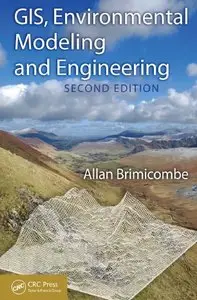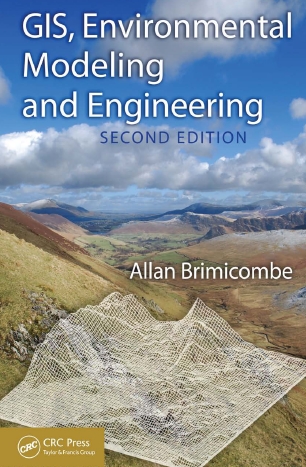"GIS, Environmental Modeling and Engineering, Second Edition" by Allan Brimicombe
Second Edition
CRC Press, Taylor & Francis Group | 2010 | ISBN: 1439808702| 380 pages | PDF/djvu | 11/6 MB
Second Edition
CRC Press, Taylor & Francis Group | 2010 | ISBN: 1439808702| 380 pages | PDF/djvu | 11/6 MB
The book defines GIS, identifies how data are structured, and explains common functionality. The author discusses modeling from a neutral scientific perspective in its role of simulating phenomena and from a more specific perspective in its role within environmental science and engineering.
The first edition of GIS, Environmental Modeling and Engineering broke new ground by linking GIS, environmental simulation, and engineering solutions. Building on this tradition, the second edition keeps the format and tone that made the first edition a bestseller while updating the content to include a diversity of case studies, better coverage of tool integration, and in-depth treatment of current issues.
New and revised information in the Second Edition:
• Data capture and compilation
• Multi-agent modeling
• Evaluation models to better convey issues of verification and validity
• Case studies focusing on on-line tools and applications
• Role of agents in interoperability
• Updated references to reflect latest research agenda
Working with GIS and environmental simulation models is not just a case of buying some hardware, some software, gathering some data, putting it all together and solving problems with the wisdom of a sage. While technology has simplified some things, many pitfalls remain. This book not only introduces the subject but also provides a guide to issues that arise when using GIS and environmental models in tandem. A structured, coherent treatment, it keeps the focus on the generic issues of using GIS and simulation models to solve real problems.
Contents
Acknowledgments
The Author
Abbreviations
Statement on Trade Names and Trademarks
1. Introduction
Metaphors of Nature
A Solution Space?
Scope and Plan of This Book
Section I
2. From GIS to Geocomputation
In the Beginning …
Technological Facilitation
Representing Spatial Phenomena in GIS
Putting the Real World onto Media
Vector
Tessellations
Object-Oriented
Data Characteristics
Data Collection Technologies
GPS and Inertial Navigation Systems
Remote Sensing
Ground Survey
Nontraditional Approaches to Data Collection
Basic Functionality of GIS
A Systems Definition of GIS
Limitations of GIS and the Rise of Geocomputation and Geosimulation
3. GIScience and the Rise of Geo-Information Engineering
Technology First …
Science to Follow …
And Now … Geo-Information Engineering
Section II
4. Approaches to Modeling
Model of an x
Typology of Models
Building Models
Modeling Landslides
Modeling Topography
Spatio-Temporal Dimensions and the Occam–Einstein Dimension
Evaluating Models
Applying Models
A Summary of Model Development
5. The Role and Nature of Environmental Models
Context of Environmental Modeling.
Environmental Impact Assessment
An Integrated Approach
Sustainable Development
Hazard, Vulnerability, and Risk
Decision Environment
Conceptual Models
Empirical Models
Models Incorporating Artificial Intelligence
Knowledge-Based Systems
Heuristics
Artificial Neural Networks
Agent-Based Models
Process Models
Lumped Parameter Models
Distributed Parameter Models
Discretization
Routing across a Digital Elevation Model
Transport through a Medium
Section III
6. Case Studies in GIS, Environmental Modeling, and Engineering
Modeling Approaches in GIS and Environmental Modeling
Spatial Coexistence
Source–Pathway Characterization
Basin Management Planning
Coastal Oil Spill Modeling
Cluster Detection
… and Don’t Forget the Web
7. Issues of Coupling the Technologies
Some Preconditions
Initial Conceptualizations
Independent
Loosely Coupled
Tightly Coupled
Embedded
An Over-Simplification of the Issues
Maturing Conceptualizations
Integration versus Interoperability
Environmental Modeling within GIS
Model Management
Maturing Typology of Integration
One-Way Data Transfer
Loose Coupling
Shared Coupling
Joined Coupling
Tool Coupling
De facto Practices
8. Data and Information Quality Issues
The Issue Is … Uncertainty
Early Warnings
So, How Come … ?
Imperfect Measurement
Digital Representation of Phenomena
Natural Variation.
Subjective Judgment and Context
Semantic Confusion
Finding a Way Forward
Measuring Spatial Data Quality
Modeling Error and Uncertainty in GIS
Topological Overlay
Interpolation.
Kriging
Fuzzy Concepts in GIS
Theory of Fuzzy Sets
Example of Fuzzy Sets in GIS
Sensitivity Analysis
Managing Fitness-for-Use
9. Modeling Issues
Issues of Scale
Issues of Algorithm
Issues of Model Structure
Issues of Calibration
Bringing Data Issues and Modeling Issues Together
10. Decision Making under Uncertainty
Exploring the Decision Space: Spatial Decision Support Systems
Communication of Spatial Concepts
Participatory Planning and the Web-Based GIS
All’s Well That Ends Well?
References
Index
1st with TOC BookMarkLinks



